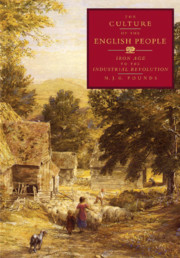Book contents
- Frontmatter
- Contents
- List of illustrations
- List of tables
- Preface
- List of abbreviations
- Map of traditional counties, with abbreviations, as used in this book
- Introduction
- 1 The view from Danebury
- 2 Roman interlude
- 3 House and household
- 4 Heat, light and insecurity
- 5 The house furnished
- 6 Food, its production, preservation and preparation
- 7 In sickness and in death
- 8 The community of parish and village
- 9 The family
- 10 The culture of cities
- 11 The foundations of popular culture
- 12 Conclusion: the end of popular culture
- Notes
- Index
8 - The community of parish and village
Published online by Cambridge University Press: 06 July 2010
- Frontmatter
- Contents
- List of illustrations
- List of tables
- Preface
- List of abbreviations
- Map of traditional counties, with abbreviations, as used in this book
- Introduction
- 1 The view from Danebury
- 2 Roman interlude
- 3 House and household
- 4 Heat, light and insecurity
- 5 The house furnished
- 6 Food, its production, preservation and preparation
- 7 In sickness and in death
- 8 The community of parish and village
- 9 The family
- 10 The culture of cities
- 11 The foundations of popular culture
- 12 Conclusion: the end of popular culture
- Notes
- Index
Summary
To exist, one had to belong to an association: a household, a manor, a monastery, a guild; there was no security except in association, and no freedom that did not recognise the obligations of a corporate life. One lived and one died in the style of one's class and corporation.
Lewis Mumford, The Culture of CitiesFew people lived alone, or, indeed, had any desire to do so. Everyone looked to membership of a group for mutual help in bad times and support in old age. Even the state in medieval England required people to be linked in small groups or tithings, so that each could vouch for the others' good behaviour. It is not that man is a particularly sociable animal: association has been forced upon him by the physical conditions in which he lived. Almost everyone is, by the accident of birth, a member of a family, of a more extended kinship group and also of a local or village community. One might leave the latter, and, perhaps with difficulty, gain acceptance in another, but family and kinship could not be replaced. Members of a family and families within a community were bound together by ties of mutual dependence. Although no family or community was ever without its internal frictions and disputes – the records are full of them – as a general rule they were never pursued to the point at which they interfered with the operation of community institutions and the performance of the agricultural routine.
- Type
- Chapter
- Information
- The Culture of the English PeopleIron Age to the Industrial Revolution, pp. 255 - 301Publisher: Cambridge University PressPrint publication year: 1994



